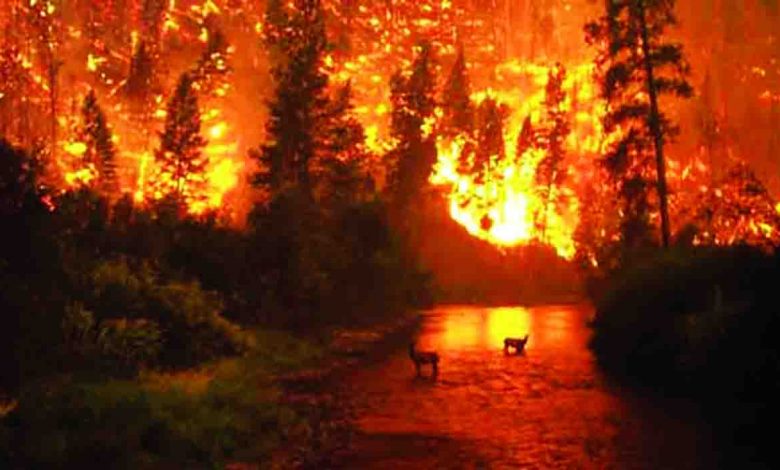Fire engulf the ecology and livelihoods in Uttarakhand

Friday, 23 April 2021 | Kota Sriraj
The most telling impact of this disaster has been on the livelihoods of the local communities that were dependent on the forests and their products
The raging forest fires in Uttarakhand have already consumed over 2,800 hectares of irreplaceable verdant forests, mainly in the higher altitudes, and as many as eight people have lost their lives due to the wildfires. The loss of wildlife is yet to be ascertained, but has to be colossal as these calamitous fires started six months ago. However, thanks to the ongoing pandemic, national as well as State resources have been steadfastly focused on fighting the Coronavirus that seems to be becoming more unmanageable with each passing day.
The Uttarakhand forest department recorded 989 fires between October 2020 and April this year and, to make matters worse, the annual rainfall was scanty also. The period between January and March this year, that usually witnesses 55 millimetres (mm) of rainfall, saw a measly 10 mm. This left the forest floor dry as tinder and provided an endless run to the forest fires.
Wildfires are frequent annual incidents all over India and the “Devbhoomi” Uttarakhand, with over 70 per cent of its area under forests, is no exception. But the fact that the State lost 85,000 football fields or 45,000 hectares of woods to forest fires over the past 20 years is a disconcerting reality. The colossal loss of ecology is only rivaled by the immense pollution generated during the course of these fires. The current fires have caused the levels of black carbon to shoot up six times to 12,000 micrograms per cubic metre of air. The most telling impact of this natural disaster has been on the livelihoods of the local communities that are dependent solely on forests and the products that come out of them.
According to the Uttarakhand State Council for Science and Technology, 80 per cent people are directly or indirectly dependent on forests either for their sustenance or subsistence. Forests provide fodder, firewood, many wild fruits, construction materials and medicines for humans and livestock. Besides, forests also provide the microclimate for the cultivation of several crops that can be grown only on the hills and provide substantial livelihood opportunities for the people living in the forest fringe areas. For instance, the harvesting and processing of the rhododendron — the State flower of Uttarakhand — has been an integral part of the local commerce for centuries. But this very source of livelihood is now being threatened by the increasing scale of forest fires every year.
The bright red flowers, growing at an altitude of 1,200 feet and above on full-sized trees, present a mesmerising visual against the backdrop of snow-clad mountains. Locally called “burans”, the rhododendron blooms are replete with time-tested medicinal properties. The tree has a flowering season between February and April and the locals earnestly look forward to the season so that they can sell these flowers, the juice and the pickle made out of the blooms. Over the last two decades, climate change has had a telling impact on the local crops as rising temperatures and drying glaciers have caused paucity of water resources leading to continuous crop failures.
Owing to the unpredictability of traditional crops, the local communities have started to depend more on harvesting of the rhododendron flowers in order to support their families. But every year the increasing intensity of wildfires during the flowering season and now the restrictions imposed in the backdrop of the COVID-19 pandemic have dealt a major blow to this small flourishing economy.
The repeated lockdowns and curfews have prevented the local people from going out to collect the leftover flowers that have not been burnt by the forest fires. Last year, the season saw a major drop of 60-70 per cent in the flower harvest, and this year, too, is not promising.
These are difficult times for all but for the population of the hills of Uttarakhand, it is an exceptionally bad time as failing crops, forest fires and a beleaguered tourism industry in the wake of the pandemic means feeding a family has become a challenge.
According to a report by the State Government, these trying circumstances have already led to a mass exodus from the villages to the cities. The report confirms that currently there are a total of 1,065 ghost villages in the State whose population has migrated to the cities in search of better prospects and livelihoods.
The Uttarakhand State Government must set up a task force to investigate the rising scale of forest fires and simultaneously provide the fire department with state-of-the-art equipment including aerial firefighters so that the difficult terrain does not hamper firefighting operations. Similarly, afforestation efforts must be redoubled to compensate for the loss of the green cover. The locals understand the significance of the forest better than anybody else and hence must be given the ownership of the same. The afforestation drives must be carried out at the tehsil-level with the involvement of local communities, to expedite the rejuvenation of lost forest cover.
The writer is an environmental journalist. The views expressed are personal.






